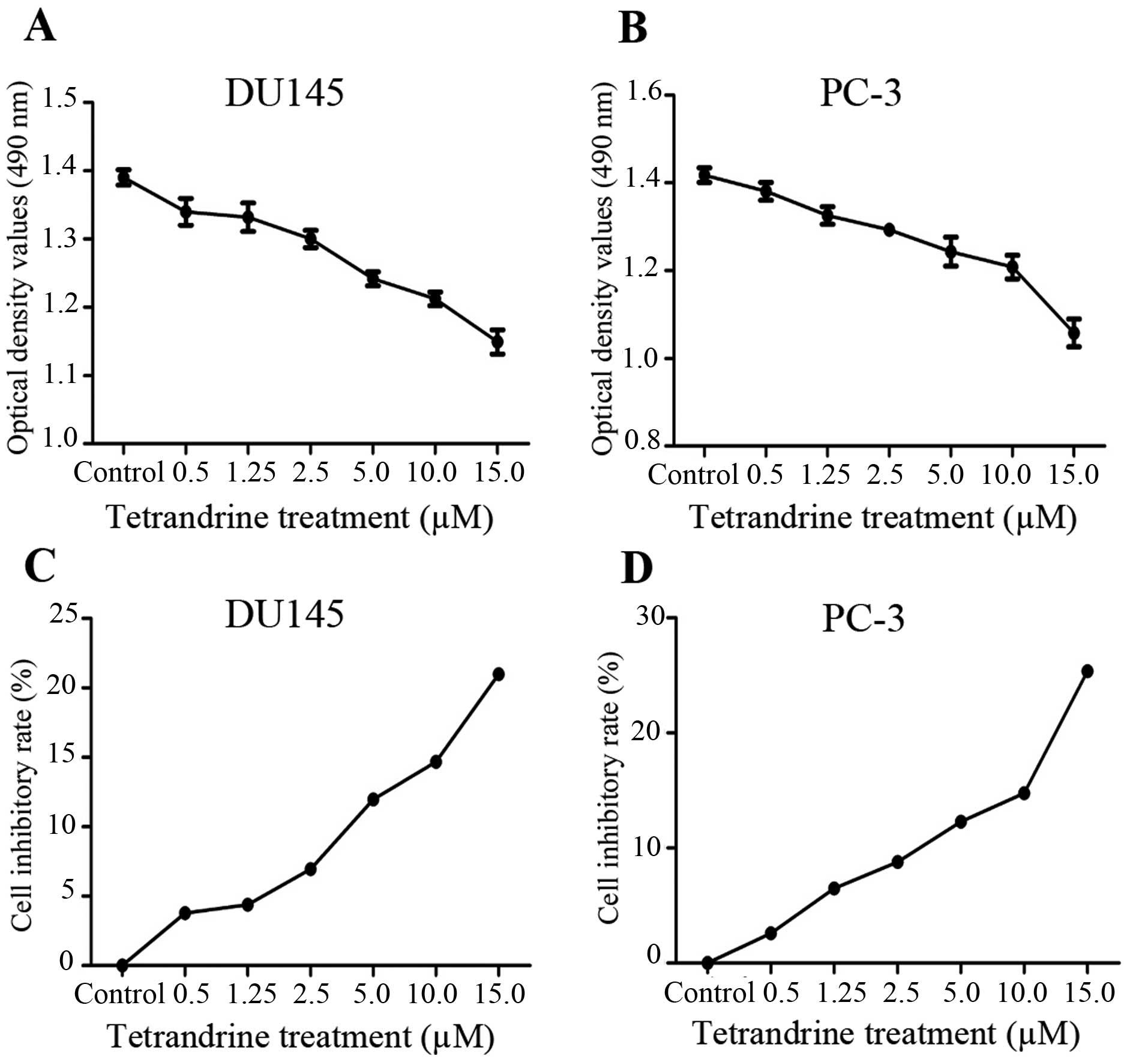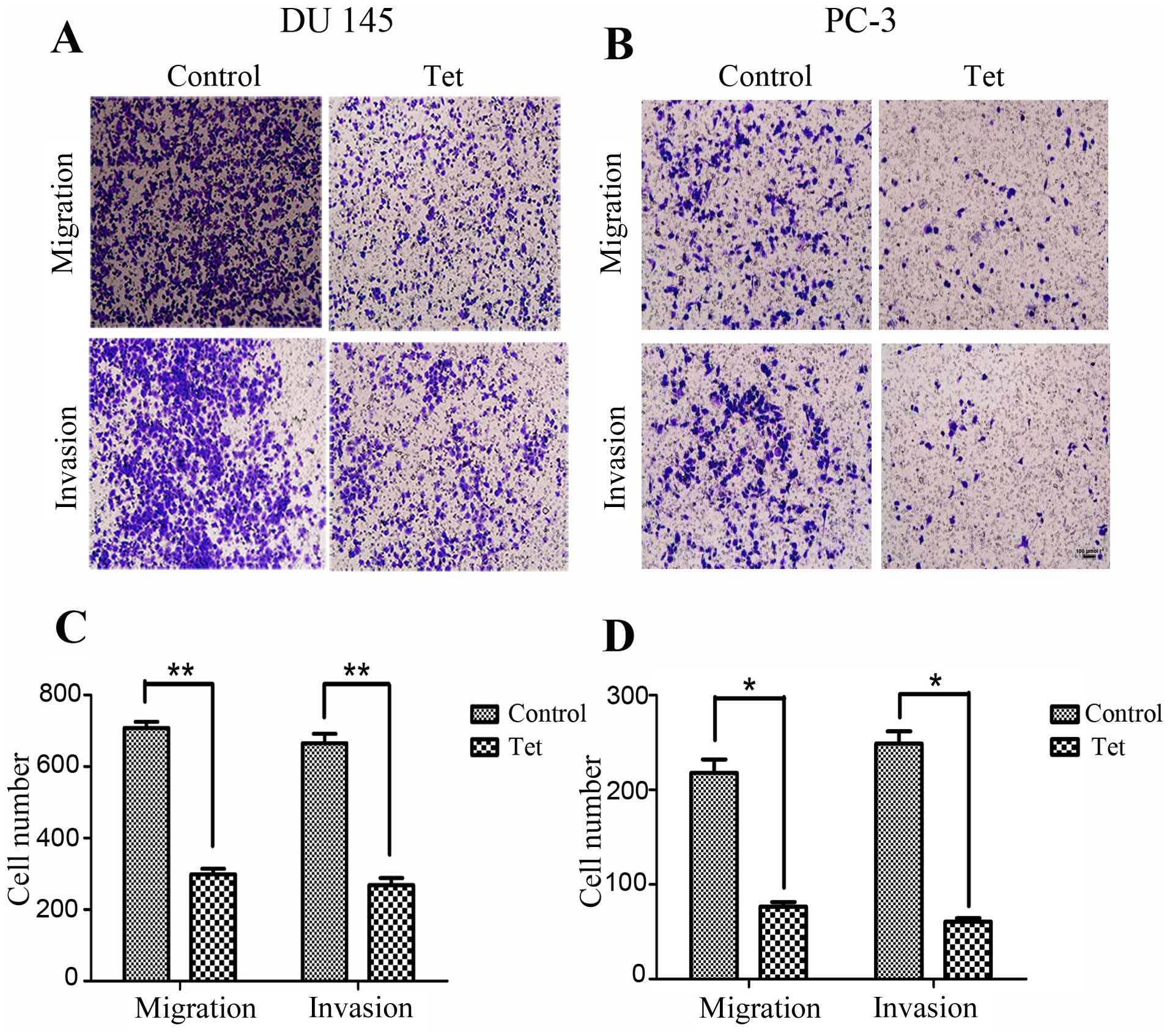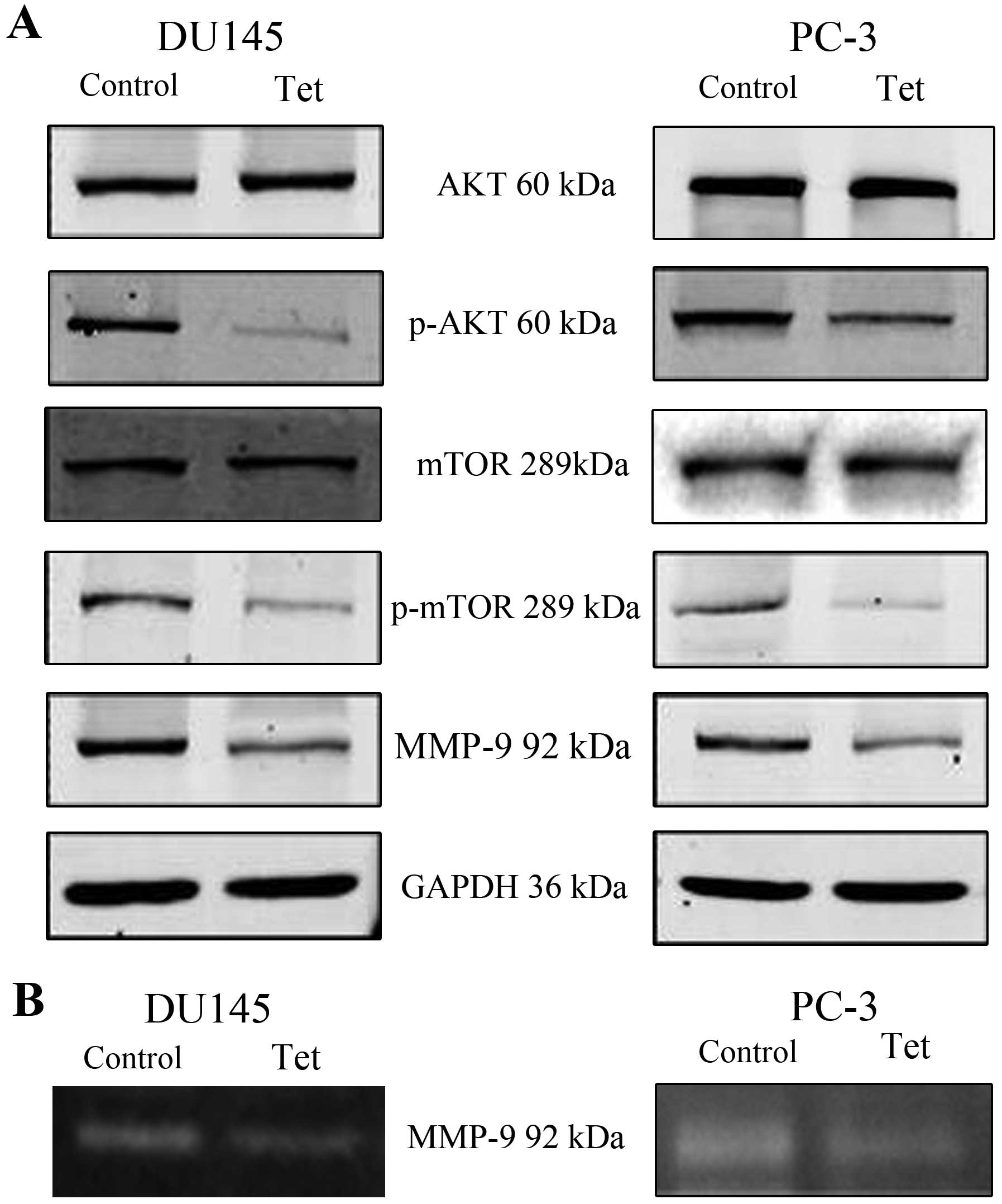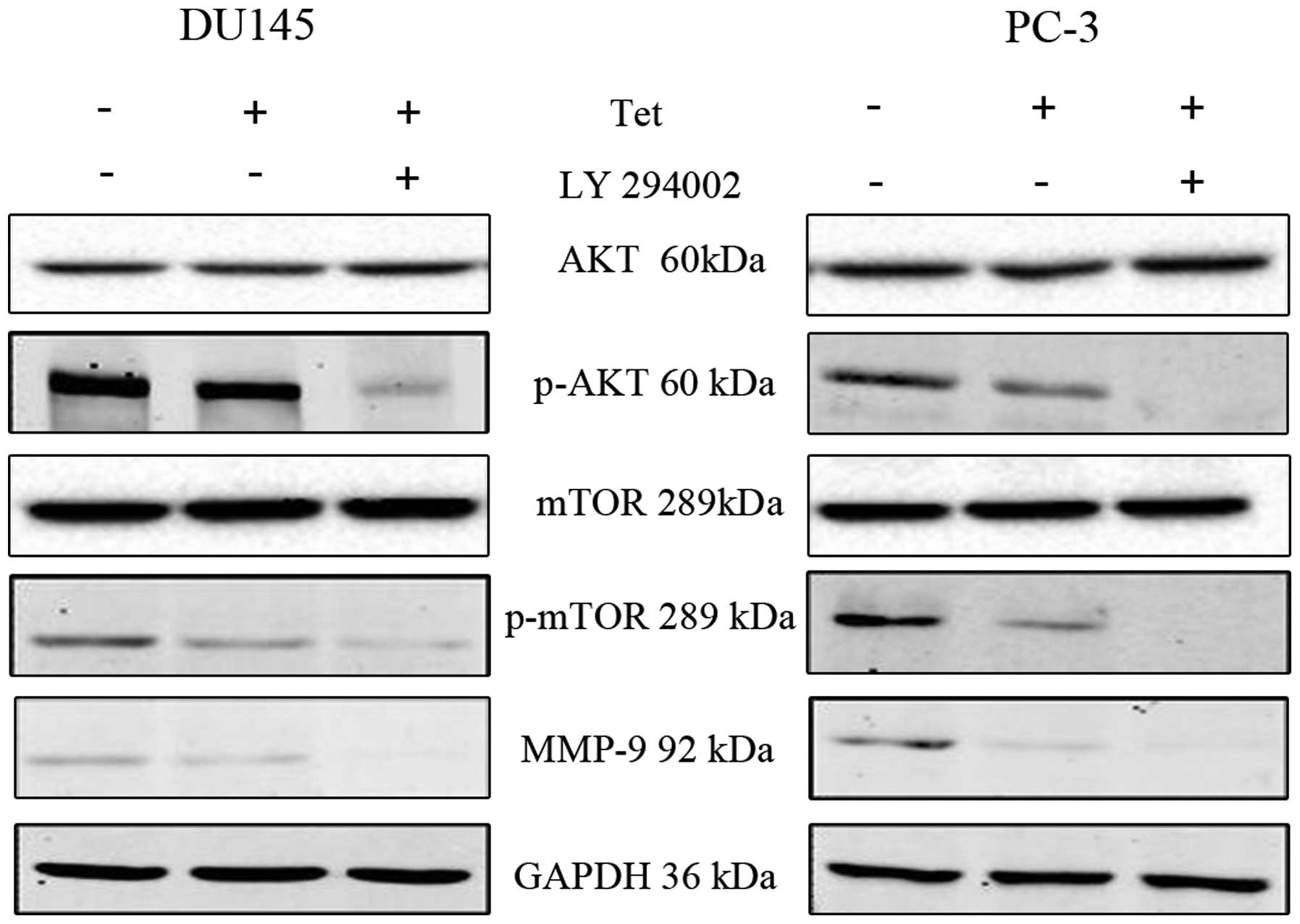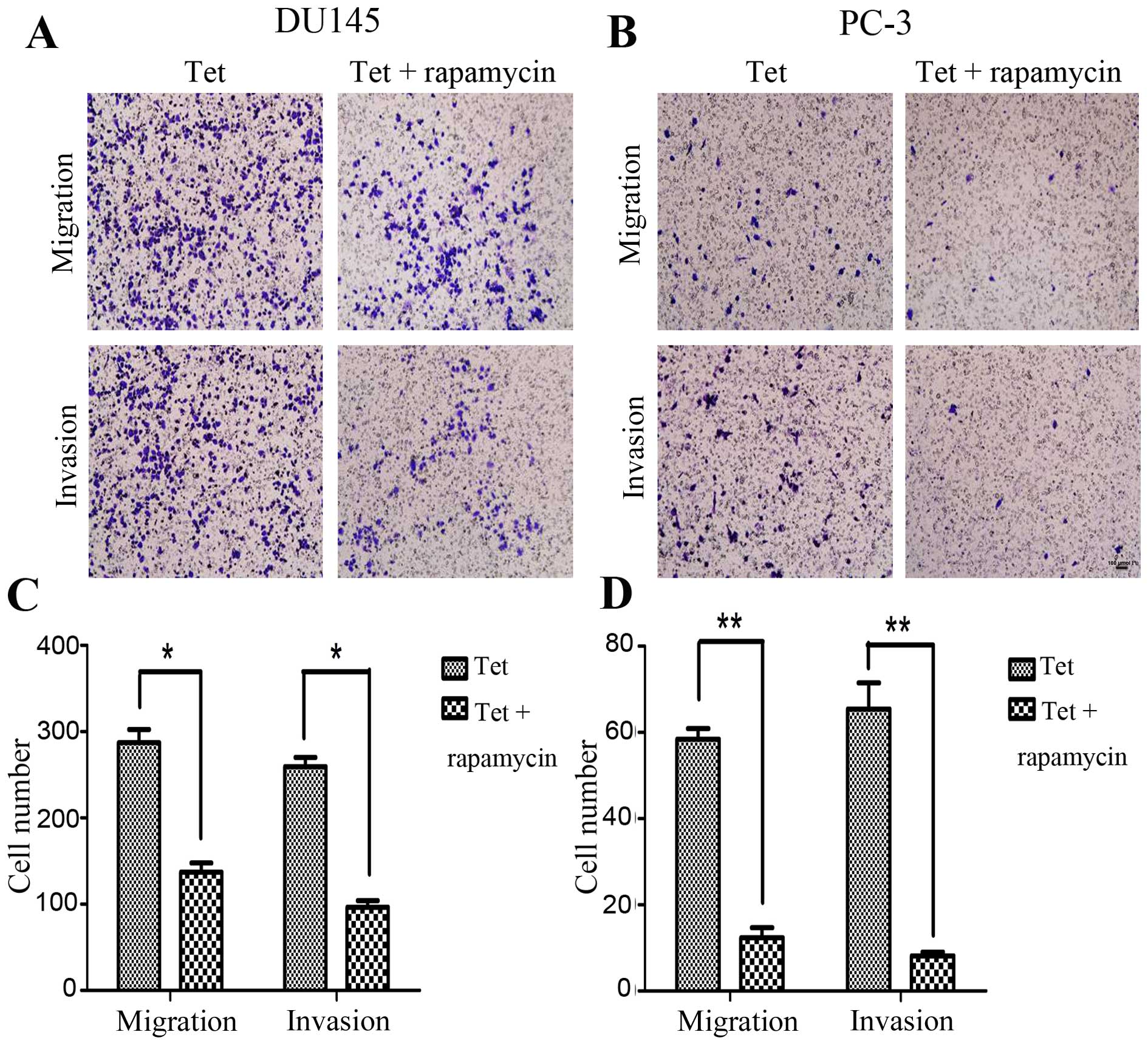Tetrandrine suppresses metastatic phenotype of prostate cancer cells by regulating Akt/mTOR/MMP-9 signaling pathway
- Authors:
- Published online on: March 3, 2016 https://doi.org/10.3892/or.2016.4649
- Pages: 2880-2886
Abstract
Introduction
Prostate cancer (PCa), one of the most prevalent malignancies in male patients worldwide, causes considerable morbidity and mortality, and a great deal of attention is currently given to its tumorigenesis. Androgen signaling based on the androgen receptor is an essential oncogenic pathway for PCa progression (1) and deprivation of androgen is used widely as the basic therapeutic strategy for patients with androgen-dependent PCa (2). Nevertheless, most patients have a recurrence with a more aggressive form, known as castration-resistant prostate cancer (CRPC) (3), with 80% of CRPC patients experiencing the presence of bony metastases. Due to its frequent metastasis and significant heterogeneity, CRPC is difficult to cure, and it has become a vexing problem for the oncologists and clinicians (4). Therefore, it is of vital importance to identify appropriate agents to kill selectively or sensitize prostate cancer.
Tetrandrine (TET) is a bisbenzylisoquinoline alkaloid with the molecular structural formula C38H42N2O6 and a molecular weight of 622.74988 g/mol. Tetrandrine isolated from the Chinese herbal medicine Stephaaniae has been applied to a very broad spectrum of pharmacological events (5), such as antihypertension, antiarrhythmia, and antirheumatism. In recent decades, tetrandrine has been used as an antifibrotic agent in the treatment of silicosis (6), and accumulating evidence suggests that tetrandrine exerts strong anticancer effects on diverse cancers in vitro, including colon (7,8), hepatoma (9), bladder (10), and lung cancer (11). The beneficial impact of tetrandrine on tumor cell multidrug resistance (12), radiosensitization (13), and angiogenesis (14) has also attracted a great deal of attention. Also, tetrandrine has been shown to modulate multiple cellular signaling events, including the Wnt/β signaling pathway (15), mitogen-activated protein kinase activation (16), and NF-κB signaling pathway.
In our previous study, we found that tetrandrine exhibited anticancer effects against PCa in vitro by suppressing cell proliferation, inducing apoptosis and inhibiting cell migration and invasion. Despite its potential as an anticancer constituent, the underlying mechanism of tetrandrine on PCa metastasis has not yet been elucidated. Therefore, we investigated the possible mechanism of tetrandrine on the inhibitory effect of metastasis in PCa DU145 and PC-3 cells.
Materials and methods
Cell culture
Human PCa cell lines DU145 and PC-3 were obtained from the American Type Culture Collection (Manassas, VA, USA). The cells were cultured in Dulbecco's modified Eagle's medium/1640 supplemented with 10% fetal bovine serum (Gibco, Grand Island, NY, USA) and 1% penicillin-streptomycin (Invitrogen, Carlsbad, CA, USA), in a humidified atmosphere with 5% CO2 at 37°C.
Reagents
Tetrandrine (C38H42N2O6) and 3-(4,5-dimethylthiazol-2-yl)-2,5-diphenyltetrazolium bromide (MTT) were purchased from Sigma Chemical Co. (St. Louis, MO, USA). Tetrandrine was diluted with 0.1 mol/l HCl at a concentration of 25 mg/ml−1, then added to the cell culture supernatant in appropriate proportions. Antibodies against Akt, phospho-Akt, the mammalian target of rapamycin (mTOR), matrix metalloproteinase-9 (MMP-9) and peroxidase-conjugated secondary antibodies were obtained from Cell Signaling Technology, Inc. (Beverly, MA, USA). LY294002 (Akt inhibitor) and rapamycin (mTOR inhibitor) were obtained from Santa Cruz Biotechnology, Inc. (Santa Cruz, CA, USA). The enhanced chemiluminescence (ECL) detection system was obtained from Amersham Life Science, Inc. (Arlington Heights, IL, USA).
MTT assay
A modified MTT assay was used to assess cell proliferation viability. Briefly, DU145 and PC-3 cells were seeded in 96-well plates (8×103 cells/well, 90% density) and incubated in the presence or absence of tetrandrine for various periods of time. Then, 0.5 mg/ml MTT dye solution was added to each well and incubated at 37°C for 4 h. After incubation, the culture medium was discarded and the cells were lysed with dimethyl sulfoxide to dissolve the formazan crystals. Absorbance at a wavelength of 490 nm was detected using a 96-well microplate reader (Bio-Rad, Hercules, CA, USA). The experiments were performed in triplicate.
Transwell migration assay
Transwell migration assays were performed using PCa DU145 and PC3 cells after treatment with tetrandrine. Cells (DU145: 6×104 or PC-3: 5×104 in 200 μl medium of serum starvation, respectively) were seeded into the top chamber, and 800 μl of medium supplemented with 10% fetal calf serum were added to the lower chamber. After incubation at 37°C for various times, cells adhering to the top chambers were removed with a cotton swab. The migratory cells on the lower surface of the membrane were fixed with 4% paraformaldehyde and stained with 0.1% crystal violet (Beyotime, Shanghai, China). Cells that migrated to the lower surface were counted in five randomly chosen visual fields under a microscope at ×100 magnification. The data were obtained from three independent experiments.
Matrigel invasion assay
The Transwell chambers (polycarbonic membrane, 6.5-mm diameter, 8 μm pore size) were coated with 50 μl Matrigel (Matrigel:serum-free medium 1:5). After incubation at 37°C for five hours, the cells (DU145: 10×104 or PC-3: 12×104 in 200 μl medium of serum starvation, respectively) were treated according to the protocol procedure, which was similar to the Transwell migration assay.
Western blotting
The PCa cells were harvested 24 h after the tetrandrine treatment, and the total cell lysates were denatured with lysis buffer [10 mmol/l Tris-HCl (pH 7.4), 150 mmol/l NaCl, 0.1% sodium dodecyl sulfate (SDS), 1 mmol/l−1 ethylenediaminetetraacetic acid, 1 mmol/l ethylene glycol tetraacetic acid, 0.3 mmol/l phenylmethylsulfonyl fluoride, 0.2 mmol/l sodium orthovanadate, 1% NP-40, 10 mg/ml leupeptin, and 10 mg/ml aprotinin]. Then clarified protein lysates (~30–60 μg whole-cell lysates, mitochondrial and cytosolic fractions) were resolved electrophoretically on denaturing SDS-polyacrylamide gel (10%) and transferred to nitrocellulose membranes. Immunoblotting was performed with the primary antibody, anti-MMP-9, as well as anti-mTOR, and p-Akt overnight at 4°C. The membranes were washed and incubated with peroxidase-conjugated secondary antibody at room temperature (25°C). Ultimately, the proteins of interest were visualized with ECL Substrate and exposed to X-ray film.
Gelatin zymography
Gelatin zymography was performed following the standardized protocol (17). Briefly, 5×105 cells were treated with tetrandrine for 24 h, after which the supernatants were collected to load onto 10% polyacrylamide gels and co-polymerized with 0.1% gelatin (Sigma). After undergoing electrophoresis, the gels were washed twice for 40 min in 2.5% Triton X-100 and 50 mmol/l Tris-HCl. Then, the gels were incubated for the next 24 h at 37°C in buffer containing 50 mmol/l Tris-HCl, 5 mmol/l CaCl2 and 0.02% NaN3, followed by staining with Coomassie brilliant G-250 and destaining with 20% methanol and 10% acetic acid. Finally, the gels were visualized with a molecular imager (ChemiDoc XRS+, Bio-Rad).
Statistical analysis
SPSS 17.0 software (SPSS Inc., Chicago, IL, USA) was used for statistical analyses. Statistical differences between the vehicle and drug treatment groups were compared by one-way analysis of variance, and Dunnett's t-test was used for multiple comparisons. Student's t-test (two-sided) was used for comparisons involving only two groups. A value of P<0.05 was considered statistically significant.
Results
Effects of tetrandrine on cell migration and invasion in prostate cancer DU145 and PC-3 cells
The MTT assays showed that cell proliferation was significantly inhibited by tetrandrine at a concentration of ≥2.5 μM in a cell density >90% (Fig. 1). In view of these results, tetrandrine at 2.5 μM (a <10% inhibitory rate) was chosen as the representative dose in the subsequent in vitro studies, to exclude the suppressing interference from PCa proliferation by tetrandrine.
To determine whether tetrandrine regulates cellular metastatic processes, we detected the effects of tetrandrine on PCa cell migration. Using a Transwell migration assay, we found that tetrandrine functioning in the DU145 cell line decreased cell migration approximately 2.5-fold after 24 h (Fig. 2A and C). Similarly, treatment of the PC-3 cells with tetrandrine resulted in a greater than 2.8-fold decrease in migration compared to the control group (Fig. 2B and D).
Next, using a Matrigel invasion assay, we explored whether tetrandrine could affect the invasiveness of PCa cells. Serum-starved cells were added to the upper chambers of the Transwell and the total number of cells invading through the Matrigel barrier in response to a chemoattractant (serum) at various times were counted. Tetrandrine significantly decreased the number of invading cells by >2.4-fold and 4-fold in the DU145 and PC-3 cells, respectively (Fig. 2).
These results suggest that tetrandrine might play a vital role in inhibiting the migration and invasion potential of human PCa cells, as indicated by the observation in the Transwell migration and Matrigel invasion assays.
Identification of the signaling pathway regulated by tetrandrine in prostate cancer
To define the underlying mechanism of tetrandrine-mediated inhibition of metastatic processes in PCa, we investigated the expression of several key factors in cancer cell migration and invasion, including E-cadherin, N-cadherin, vimentin, and MMP-9. To determine the impact of tetrandrine on the production of proteinases by DU145 and PC-3, protein lysates were collected and subjected to SDS-polyacrylamide gel electrophoresis. As shown in Fig. 3, the presence of proteinases led to a clear band at 92 kDa in the nitrocellulose membranes, which was assigned to MMP-9, and tetrandrine reduced MMP-9 protein levels (Fig. 3A) and decreased MMP-9 activity (Fig. 3B), which corresponded to the inhibition of invasiveness in the DU145 and PC-3 cells. However, the protein levels of E-cadherin, N-cadherin and vimentin in the tetrandrine treatment remained the same (data not shown).
To detect the upstream of MMP-9, we found that the pretreatment with tetrandrine resulted in a marked decrease in the protein levels of phosphorylated Akt (p-Akt) and phosphorylated mTOR (p-mTOR) in both the DU145 and PC-3 cells (Fig. 3). To gain further insights into the molecular mechanisms of tetrandrine in the PCa metastasis process, LY294002 (Akt inhibitor) or rapamycin (mTOR inhibitor) was selected to combine with tetrandrine for functional and mechanism research. The data showed that pretreatment with LY294002 decreased the tetrandrine-inhibited migration and invasion in the DU145 and PC-3 cells (Fig. 4), and reduced the p-mTOR and MMP-9 protein levels (Fig. 5) much more significantly compared with the tetrandrine alone group. This result suggests that Akt protein was passably related to the antimetastasis effect of tetrandrine.
Given that Akt protein might contribute to the anticancer activity of tetrandrine, the downstream of Akt was evaluated to define further the molecular basis of tetrandrine-inhibited metastasis. Similar results were observed in a combination of tetrandrine and rapamycin. The combined effect of the two agents was found to suppress prostate cancer cell migration and invasion (Fig. 6), and diminish of MMP-9 protein levels more effectively (Fig. 7); there was no significant change in NF-κB protein level (data not shown).
Taken together, our findings show that the Akt/mTOR/MMP-9 signaling pathway was partially associated with tetrandrine-inhibited metastasis in CRPC cells, suggesting that tetrandrine might be a potential promising agents in the suppression of metastatic phenotypes in PCa treatment.
Discussion
In recent decades, the incidence of PCa has increased sharply in Asian countries (18). Until now, the majority of clinical trials have achieved limited benefits in the treatment of advanced PCa, mainly because of the high incidence of invasion and metastasis. Metastasis, a symbol of malignancy, is the migration of cancer cells from the original tumor site to distant organs through the bloodstream or lymph system. Metastasis development is a multi-step process that is implicated in such activities as local invasion, transfer, extravasation, and tumor deposit (19). Shedding light on the mechanisms that facilitate tumor cell migration and invasion is of major concern in cancer research, as approximately 90% of deaths from solid tumors arise from metastasis. The median survival rate for patients with metastatic PCa is far less than five years while the opposite is true for men with localized disease (19). Based on these factors, it is known that the tendency to invade and transfer is one of the obstacles facing PCa treatments. Hence, there is an urgent need to develop new agents for PCa therapy.
Tetrandrine, a traditional Chinese medicine, has been shown to exhibit a wide range of uses. Accumulating evidence indicates that tetrandrine exerts antitumor effects against various cancer cells in vitro by inducing cell cycle arrest and inhibiting angiogenesis. In our previous study, we found that the induction of PCa cell apoptosis by tetrandrine might be mediated partially by the activation of caspase cascade. Nevertheless, it is conceivable that the anticancer activity of tetrandrine might be involved with many other signaling pathways. It has been reported that tetrandrine induces apoptosis in hepatocellular carcinoma cells by generating reactive oxygen species, followed by the repression of Akt activity (20). Tetrandrine also exhibits anti-proliferation effects by targeting β-catenin activity to a certain extent. In addition, it has been reported that tetrandrine inhibited in vivo tumor metastasis in a mouse model of stage IV breast cancer. The inhibitory effect of tetrandrine on breast cancer metastasis might be mediated partly by regulating endothelial cell-specific molecule-1 (ESM-1), integrin β5 protein and intercellular cell adhesion molecule-1 (ICAM-1) levels (21).
Metastasis in patients with PCa is one of the main lethal factors blocking direct treatment. In our studies, the impact of tetrandrine resulted in decreased cell migration and invasion in the metastatic CRPC cell lines DU145 and PC-3. Identifying the molecular mechanisms of tetrandrine on the metastatic process underlying PCa is crucial in order to clarify our understanding of tumorigenesis and metastasis. As such, we have detected the expression of several key factors in the cell metastatic process and found that tetrandrine might decrease MMP-9 protein levels and activity in two independent CRPC cell lines; however, we found no significant changes in MMP-2 protein levels. These findings indicate that MMP-9 deregulation could be a vital event in PCa progression and are consistent with our data that tetrandrine expression resulted in decreased MMP-9 levels and a decline in metastatic traits.
In addition to speculating that MMP-9 might be associated with anti-metastasis activity displayed by tetrandrine, we also measured the Akt signaling pathway, which is upstream of MMP-9. The results showed that p-Akt and p-mTOR protein levels decreased significantly with tetrandrine treatment. Next, to determine whether the ability of tetrandrine to inhibit PCa metastasis was mediated through a decrease in p-Akt and p-mTOR kinase activity, we treated DU145 and PC-3 cells with tetrandrine in combination with LY294002 and rapamycin, respectively, and then documented cell migration and invasion using Transwell assay and western blotting. Our data in the present study demonstrated that the inhibition of metastasis in DU145 and PC3 cells by tetrandrine was markedly enhanced in combination with LY294002 or rapamycin pre-treatment.
Furthermore, tetrandrine and LY294002 synergistically decreased p-mTOR and MMP-9 protein levels, and rapamycin worked in the same manner. However, whether the decrease in p-mTOR protein level is directly related to downregulation of MMP-9 protein needs to be investigated further. These data suggest that, at least partially, the Akt/mTOR/MMP-9 signaling pathway is involved in the tetrandrine-mediated metastatic inhibition of PCa. However, several limitations exist in our study. On the one hand, the lack of animal models in our studies is a short coming, and further considerations should be taken about tetrandrine's function on animal models in our future study. On the other hand, we only observe the anti-metastatic effect of tetrandrine on prostate cancer cells by negatively regulating Akt/mTOR/MMP-9 signaling pathway. Whether alternative signaling pathways participated in this effect of tetrandrine has not yet been elucidated. Hence, it is of necessity for us to resolve these questions in further research.
While our studies have shown that tetrandrine is valid as a single agent for tumor therapy, it might be rational to speculate that it will be used widely in combination with other agents in the clinical setting. Our findings demonstrated that tetrandrine decreased not only p-Akt and p-mTOR activity, but also showed good synergy with LY294002 or rapamycin in the inhibition of PCa cells. Thus, our studies suggest that tetrandrine might be a stronger chemotherapeutic agent when combined with LY294002 or rapamycin.
To the best of our knowledge, our studies provide the first evidence that tetrandrine inhibits PCa cells metastasis by repressing Akt/mTOR and inactivating MMP-9 and that Akt/mTOR appear to be the upstream regulators of MMP-9 inactivation. In conclusion, it is suggested that tetrandrine suppresses metastasis by negatively regulating the Akt/mTOR/MMP-9 signaling pathway, and that it could serve as a potential inhibitor of tumor metastasis in future therapeutic interventions in PCa patients.
Acknowledgments
This study was partially supported by the Science and Technology Research Projects of Shaanxi (2014K-11-03-01-03).
References
|
Goto Y, Kojima S, Nishikawa R, Enokida H, Chiyomaru T, Kinoshita T, Nakagawa M, Naya Y, Ichikawa T and Seki N: The microRNA-23b/27b/24-1 cluster is a disease progression marker and tumor suppressor in prostate cancer. Oncotarget. 5:7748–7759. 2014. View Article : Google Scholar : PubMed/NCBI | |
|
Chaudhary P and Vishwanatha JK: c-Jun NH2-terminal kinase-induced proteasomal degradation of c-FLIPL/S and Bcl2 sensitize prostate cancer cells to Fas- and mitochondria-mediated apoptosis by tetrandrine. Biochem Pharmacol. 91:457–473. 2014. View Article : Google Scholar : PubMed/NCBI | |
|
Lamont KR and Tindall DJ: Minireview: Alternative activation pathways for the androgen receptor in prostate cancer. Mol Endocrinol. 25:897–907. 2011. View Article : Google Scholar : PubMed/NCBI | |
|
Shamash J, Dancey G, Barlow C, Wilson P, Ansell W and Oliver RT: Chlorambucil and lomustine (CL56) in absolute hormone refractory prostate cancer: Re-induction of endocrine sensitivity an unexpected finding. Br J Cancer. 92:36–40. 2005. View Article : Google Scholar | |
|
Chen YJ: Potential role of tetrandrine in cancer therapy. Acta Pharmacol Sin. 23:1102–1106. 2002.PubMed/NCBI | |
|
Pang L and Hoult JR: Cytotoxicity to macrophages of tetrandrine, an antisilicosis alkaloid, accompanied by an overproduction of prostaglandins. Biochem Pharmacol. 53:773–782. 1997. View Article : Google Scholar : PubMed/NCBI | |
|
Wu JM, Chen Y, Chen JC, Lin TY and Tseng SH: Tetrandrine induces apoptosis and growth suppression of colon cancer cells in mice. Cancer Lett. 287:187–195. 2010. View Article : Google Scholar | |
|
Wu K, Zhou M, Wu QX, Yuan SX, Wang DX, Jin JL, Huang J, Yang JQ, Sun WJ, Wan LH, et al: The role of IGFBP-5 in mediating the anti-proliferation effect of tetrandrine in human colon cancer cells. Int J Oncol. 46:1205–1213. 2015. | |
|
Ng LT, Chiang LC, Lin YT and Lin CC: Antiproliferative and apoptotic effects of tetrandrine on different human hepatoma cell lines. Am J Chin Med. 34:125–135. 2006. View Article : Google Scholar : PubMed/NCBI | |
|
Li X, Su B, Liu R, Wu D and He D: Tetrandrine induces apoptosis and triggers caspase cascade in human bladder cancer cells. J Surg Res. 166:e45–e51. 2011. View Article : Google Scholar | |
|
Lee JH, Kang GH, Kim KC, Kim KM, Park DI, Choi BT, Kang HS, Lee YT and Choi YH: Tetrandrine-induced cell cycle arrest and apoptosis in A549 human lung carcinoma cells. Int J Oncol. 21:1239–1244. 2002.PubMed/NCBI | |
|
Sun YF and Wink M: Tetrandrine and fangchinoline, bisbenzylisoquinoline alkaloids from Stephania tetrandra can reverse multidrug resistance by inhibiting P-glycoprotein activity in multidrug resistant human cancer cells. Phytomedicine. 21:1110–1119. 2014. View Article : Google Scholar : PubMed/NCBI | |
|
Wang TH, Wan JY, Gong X, Li HZ and Cheng Y: Tetrandrine enhances cytotoxicity of cisplatin in human drug-resistant esophageal squamous carcinoma cells by inhibition of multidrug resistance-associated protein 1. Oncol Rep. 28:1681–1686. 2012.PubMed/NCBI | |
|
Xiao W, Jiang Y, Men Q, Yuan L, Huang Z, Liu T, Li W and Liu X: Tetrandrine induces G1/S cell cycle arrest through the ROS/Akt pathway in EOMA cells and inhibits angiogenesis in vivo. Int J Oncol. 46:360–368. 2015. | |
|
He BC, Gao JL, Zhang BQ, Luo Q, Shi Q, Kim SH, Huang E, Gao Y, Yang K, Wagner ER, et al: Tetrandrine inhibits Wnt/β-catenin signaling and suppresses tumor growth of human colorectal cancer. Mol Pharmacol. 79:211–219. 2011. View Article : Google Scholar : | |
|
Qin R, Shen H, Cao Y, Fang Y, Li H, Chen Q and Xu W: Tetrandrine induces mitochondria-mediated apoptosis in human gastric cancer BGC-823 cells. PLoS One. 8:e764862013. View Article : Google Scholar : PubMed/NCBI | |
|
Toth M, Sohail A and Fridman R: Assessment of gelatinases (MMP-2 and MMP-9) by gelatin zymography. Methods Mol Biol. 878:121–135. 2012. View Article : Google Scholar : PubMed/NCBI | |
|
Sim HG and Cheng CW: Changing demography of prostate cancer in Asia. Eur J Cancer. 41:834–845. 2005. View Article : Google Scholar : PubMed/NCBI | |
|
Gupta GP and Massagué J: Cancer metastasis: Building a framework. Cell. 127:679–695. 2006. View Article : Google Scholar : PubMed/NCBI | |
|
Liu C, Gong K, Mao X and Li W: Tetrandrine induces apoptosis by activating reactive oxygen species and repressing Akt activity in human hepatocellular carcinoma. Int J Cancer. 129:1519–1531. 2011. View Article : Google Scholar | |
|
Gao JL, Ji X, He TC, Zhang Q, He K, Zhao Y, Chen SH and Lv GY: Tetrandrine suppresses cancer angiogenesis and metastasis in 4T1 tumor bearing mice. Evid Based Complement Alternat Med. 2013:2650612013. View Article : Google Scholar : PubMed/NCBI |



